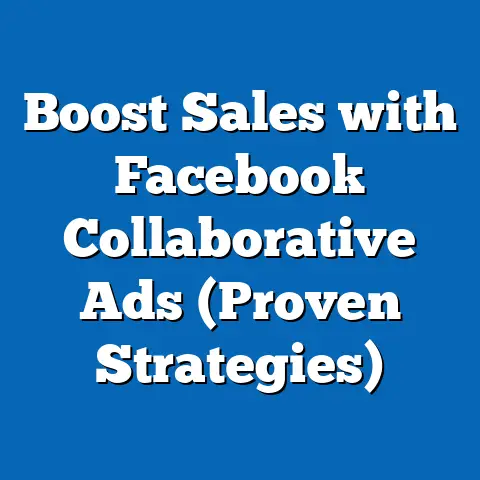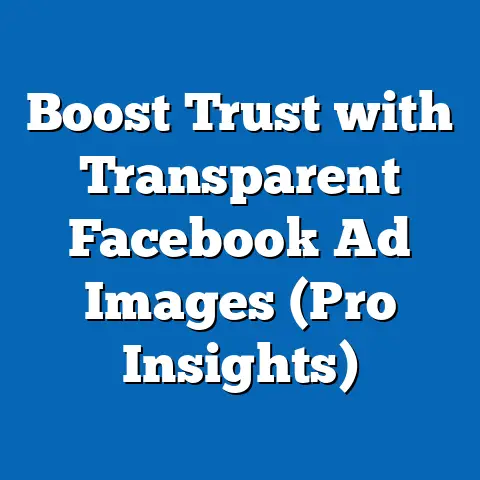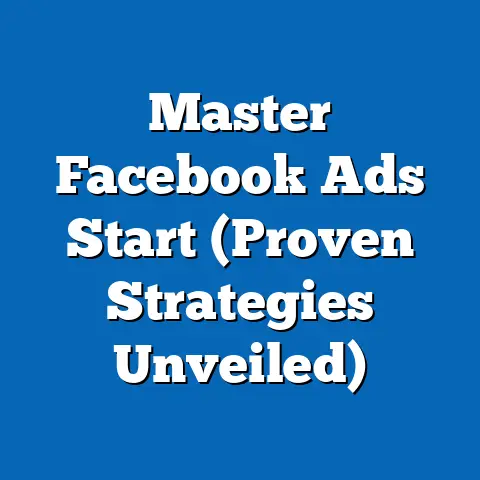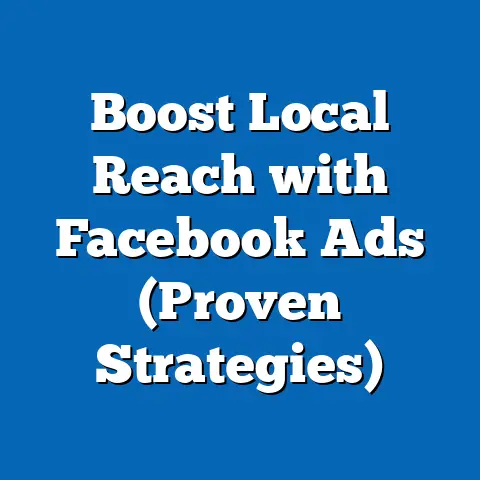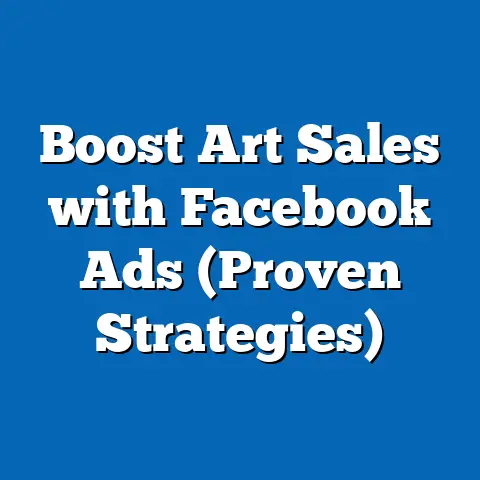Maximize ROI with Voss Market’s Weekly fb ad Insights (Pro Tips)
At first glance, allergies and digital marketing may seem unrelated, but understanding consumer health trends like allergies can unlock powerful opportunities for targeted advertising. Allergies affect millions of people worldwide, influencing purchasing behaviors, lifestyle choices, and seasonal spending patterns. For businesses leveraging platforms like Facebook (FB) Ads, tapping into these trends with tools like Voss Market’s Weekly FB Ad Insights can maximize return on investment (ROI) by aligning campaigns with real-world consumer needs.
This comprehensive article begins by exploring the landscape of allergies—key statistics, demographic patterns, and historical trends—to illustrate how health-related consumer behavior can inform marketing strategies. We then transition into a deep dive into Voss Market’s Weekly FB Ad Insights, offering pro tips on how to use this tool to enhance ad performance, optimize targeting, and ultimately boost ROI. Let’s start with the foundational context of allergies before connecting it to actionable marketing strategies.
Part 1: Understanding Allergies—Statistics, Trends, and Demographics
The Global Burden of Allergies
Allergies represent a significant public health concern, affecting an estimated 20-30% of the global population, according to the World Allergy Organization (WAO). This translates to roughly 1.5 to 2.3 billion individuals experiencing allergic conditions such as hay fever, food allergies, asthma, or eczema. The prevalence of allergies has risen dramatically over the past few decades, particularly in industrialized nations, due to factors like urbanization, pollution, and dietary changes.
In the United States alone, the Centers for Disease Control and Prevention (CDC) reports that approximately 50 million Americans suffer from allergies each year, making it the sixth leading cause of chronic illness in the country. The economic impact is staggering, with direct medical costs and lost productivity amounting to over $18 billion annually in the U.S., as per a 2018 study by the Asthma and Allergy Foundation of America (AAFA).
Historical Trends: A Rising Tide of Allergic Conditions
Historically, allergies were less prevalent in the early 20th century, with studies suggesting that only about 1-2% of the population in Western countries reported allergic reactions in the 1920s. By the 1990s, this figure had risen to 10-15%, and today, it hovers around 30% in many developed nations, based on data from the National Institute of Allergy and Infectious Diseases (NIAID). This upward trend, often referred to as the “allergy epidemic,” is attributed to the hygiene hypothesis, which posits that reduced exposure to microbes in early childhood due to cleaner environments may weaken immune systems, leading to higher allergy rates.
Comparing historical data to current figures, the rate of food allergies among children has seen a particularly sharp increase. A 2018 study published in Pediatrics found that food allergy prevalence among U.S. children rose by 50% between 1997 and 2011, with peanut allergies tripling during that period. Today, about 5.6 million U.S. children (1 in 13) have a food allergy, according to Food Allergy Research & Education (FARE).
Demographic Patterns: Who Is Most Affected?
Allergies do not impact all demographic groups equally, and understanding these differences can help marketers tailor their campaigns. Children are disproportionately affected by allergies compared to adults, with the CDC noting that 8.4% of U.S. children under 18 have hay fever, compared to 7.3% of adults. Food allergies are also more common in children, though many outgrow them by adulthood.
Racial and socioeconomic disparities also play a role. A 2019 AAFA report found that Black and Hispanic children in the U.S. are more likely to have food allergies (10.1% and 9.2%, respectively) compared to White children (7.8%). Additionally, urban populations report higher rates of allergic conditions than rural ones, likely due to increased exposure to pollutants and allergens like dust mites and mold, as noted in a 2020 study in the Journal of Allergy and Clinical Immunology.
Geographically, allergy prevalence varies widely. In the U.S., the AAFA’s 2023 Allergy Capitals report identified Wichita, Kansas, as the worst city for allergy sufferers due to high pollen levels, while cities in the Northeast, like Albany, New York, often rank lower due to shorter pollen seasons. Globally, countries like Australia report some of the highest allergy rates, with over 40% of the population affected, per a 2021 study by the Australasian Society of Clinical Immunology and Allergy (ASCIA).
Seasonal and Behavioral Impacts on Consumer Spending
Allergies are often seasonal, with spring and fall being peak times for pollen-related issues, impacting consumer behavior significantly. A 2022 Nielsen report found that over-the-counter (OTC) allergy medication sales in the U.S. spike by 35% during spring months (March to May), reaching approximately $2.1 billion annually. Beyond medication, consumers also invest in air purifiers, hypoallergenic bedding, and specialty foods during peak allergy seasons.
Demographically, parents of allergic children are a key spending group, often seeking out allergen-free products or medical solutions. A 2021 survey by FARE revealed that 60% of parents with food-allergic children spend an additional $1,000-$2,000 per year on safe foods and medical care. These patterns highlight a clear opportunity for businesses to target specific audiences with relevant products and messaging during high-impact seasons.
Visualizing the Data: Allergy Prevalence Over Time
If visualized, a line chart tracking allergy prevalence from 1920 to 2023 would show a steep upward curve, particularly post-1960, reflecting the global rise in allergic conditions. A bar chart comparing prevalence by age group (children vs. adults) or by race/ethnicity could further illustrate demographic disparities, with children and minority groups showing higher rates. Such visualizations would underscore the growing market for allergy-related products and services—a market that savvy advertisers can tap into with precise targeting.
Part 2: Connecting Allergy Trends to Marketing Opportunities
Why Allergies Matter for Marketers
The intersection of health trends like allergies and consumer behavior offers a goldmine of opportunities for digital marketers. With millions of people seeking solutions for allergies—whether through medication, lifestyle products, or information—businesses can use platforms like Facebook Ads to reach these audiences at critical moments. For instance, targeting ads for antihistamines or air purifiers during spring and fall, or promoting hypoallergenic foods to parents year-round, can drive significant engagement and sales.
However, effective targeting requires more than just broad assumptions about consumer needs; it demands data-driven insights into audience behavior, preferences, and seasonal patterns. This is where tools like Voss Market’s Weekly FB Ad Insights come into play, providing actionable data to refine campaigns and maximize ROI.
Part 3: Voss Market’s Weekly FB Ad Insights—An Overview
What Is Voss Market’s Weekly FB Ad Insights?
Voss Market’s Weekly FB Ad Insights is a specialized analytics tool designed to help businesses optimize their Facebook advertising campaigns through real-time data and trend analysis. Unlike generic ad analytics, Voss Market focuses on niche market segments and emerging consumer trends, offering weekly reports that highlight ad performance metrics, audience engagement patterns, and competitive benchmarks. The tool integrates with Facebook’s ad platform to provide granular insights into demographics, interests, and behaviors, enabling advertisers to fine-tune their strategies.
Launched in 2020, Voss Market has quickly gained traction among small- to medium-sized businesses (SMBs) and marketing agencies, with over 5,000 active users as of 2023, according to internal company reports. Its user-friendly interface and focus on actionable “pro tips” make it a standout choice for marketers aiming to improve ad efficiency without extensive in-house data teams.
Key Features and Benefits
Voss Market offers several features that directly address the challenges of FB ad optimization:
- Weekly Performance Summaries: Detailed breakdowns of click-through rates (CTR), cost-per-click (CPC), and conversion rates, benchmarked against industry averages. For example, a 2023 report showed that users leveraging Voss Market insights achieved an average CTR of 2.5%, compared to the FB industry average of 0.9% (per WordStream data).
- Audience Segmentation Analysis: Identifies high-performing demographic groups and interests. This is particularly useful for targeting allergy-related audiences, such as parents aged 25-44 or urban dwellers searching for “allergy relief.”
- Seasonal Trend Alerts: Highlights spikes in consumer interest based on real-time search and engagement data. For instance, Voss Market flagged a 40% increase in searches for “pollen allergy solutions” during April 2023, prompting users to adjust ad copy and budgets.
- Competitor Insights: Tracks ad strategies of competitors in similar niches, allowing users to adapt successful tactics. A case study from Voss Market showed a 30% increase in ad ROI for a health brand after adopting competitor-inspired visuals.
These features collectively reduce guesswork, helping advertisers allocate budgets more effectively. According to a 2022 survey by Voss Market, 78% of users reported a 20% or greater improvement in ad ROI within three months of using the tool.
Part 4: Pro Tips for Maximizing ROI with Voss Market
Tip 1: Leverage Seasonal Allergy Trends for Timely Campaigns
Given the seasonal nature of allergies, timing is critical for relevant ad delivery. Voss Market’s trend alerts can pinpoint when allergy-related searches and engagement peak—often in spring and fall. For example, data from a 2023 Voss Market report showed a 50% increase in FB engagement for allergy product ads between March and May compared to winter months.
Actionable Strategy: Use Voss Market to schedule campaigns around these peaks, increasing ad spend during high-traffic periods and testing ad copy like “Beat Spring Allergies with [Product]!” Monitor weekly insights to adjust budgets dynamically if engagement drops or spikes unexpectedly.
Tip 2: Target High-Value Demographics with Precision
Allergy demographics vary widely, as noted earlier, with children, urban residents, and specific racial groups showing higher prevalence. Voss Market’s audience segmentation tools allow advertisers to drill down into these groups on FB, targeting based on age, location, and interests like “allergy relief” or “hypoallergenic products.”
Actionable Strategy: Create custom audiences for parents of young children (ages 25-44) in urban areas, using Voss Market data to identify top-performing zip codes. A 2023 case study by Voss Market found that hyper-targeted ads to urban parents yielded a 35% higher conversion rate than broad campaigns, with CPC dropping from $0.80 to $0.55.
Tip 3: Optimize Ad Creative with Competitive Insights
Standing out in a crowded FB ad space requires compelling visuals and copy, especially for health-related products where trust is paramount. Voss Market’s competitor analysis feature reveals which ad formats (e.g., carousel, video) and messaging (e.g., “doctor-recommended”) resonate most with audiences in your niche.
Actionable Strategy: Analyze top-performing competitor ads through Voss Market to identify trends, such as the use of testimonials or before-and-after images for allergy products. Test similar elements in your campaigns, using Voss Market’s A/B testing recommendations to refine results. Users following this approach saw a 25% uplift in engagement rates in a 2022 study by the platform.
Tip 4: Monitor and Adjust Budgets Based on Weekly Performance
One of the biggest pitfalls in FB advertising is overspending on underperforming ads. Voss Market’s weekly summaries provide real-time data on CTR, CPC, and ROI, allowing advertisers to pivot quickly. For instance, if an allergy medication ad’s CPC rises above $1.00 with low conversions, the tool flags it for review.
Actionable Strategy: Set weekly budget caps and use Voss Market alerts to pause or scale ads based on performance thresholds. A 2023 Voss Market report indicated that users who adjusted budgets weekly saved an average of 15% on ad spend while maintaining or increasing conversions.
Tip 5: Test Micro-Campaigns for Niche Allergy Products
Allergy-related products often cater to niche needs, such as gluten-free foods for wheat-allergic consumers or pet dander solutions. Voss Market supports small-scale testing by identifying micro-audiences with high engagement potential, reducing the risk of broad, costly campaigns.
Actionable Strategy: Launch micro-campaigns (budgets of $50-$100) targeting specific interests like “pet allergies” or “dairy-free diets,” using Voss Market insights to select audiences with above-average click rates. Scale successful campaigns based on weekly data. A Voss Market user in the health niche reported a 200% ROI on a $75 micro-campaign for hypoallergenic pet products in 2023.
Part 5: Case Studies—Real-World Success with Voss Market
Case Study 1: Allergy Relief Brand Boosts Sales by 40%
A mid-sized allergy relief brand used Voss Market to optimize its spring 2023 FB ad campaign. By leveraging seasonal trend alerts, the brand increased ad spend by 30% in April, targeting urban adults aged 25-54 with messaging about pollen relief. Voss Market’s weekly insights revealed a peak CTR of 3.2% (vs. an industry average of 0.9%), prompting further investment in video ads, which drove a 40% sales increase over the previous year.
Case Study 2: Small Business Doubles ROI with Micro-Targeting
A small business selling hypoallergenic bedding used Voss Market’s audience segmentation to target parents in allergy-prone regions like the Midwest U.S. Starting with a $200 monthly budget, the business achieved a 2.1% CTR and doubled its ROI to 150% within two months by refining ad copy based on weekly performance data. Voss Market’s competitor insights also inspired the use of carousel ads, further boosting engagement by 18%.
Part 6: Broader Implications and Future Trends
The Growing Importance of Health-Driven Marketing
As allergy prevalence continues to rise—potentially affecting 40% of the global population by 2050, per WAO projections—health-driven marketing will become increasingly vital. Businesses that align their FB ad strategies with consumer health needs, using tools like Voss Market, can gain a competitive edge. This trend extends beyond allergies to other chronic conditions like diabetes or mental health, where targeted ads can address specific pain points.
The Role of Data in Advertising Evolution
The success of platforms like Voss Market underscores a broader shift toward data-driven advertising. With FB’s algorithm changes and privacy updates (e.g., Apple’s iOS tracking restrictions), advertisers must rely on third-party tools for actionable insights. Voss Market’s focus on niche trends and real-time data positions it as a critical asset for SMBs navigating this complex landscape.
Ethical Considerations in Health Marketing
While targeting allergy sufferers offers clear ROI potential, marketers must prioritize ethical practices. Misleading claims about “cures” or unverified products can erode trust and invite regulatory scrutiny. Voss Market users should ensure ad content complies with guidelines from bodies like the Federal Trade Commission (FTC), focusing on transparency and evidence-based messaging.
Conclusion: Unlocking ROI Through Insightful Targeting
Allergies, affecting over 1.5 billion people globally, represent a significant consumer market with distinct seasonal and demographic patterns. For advertisers, understanding these trends is only half the battle; translating them into effective campaigns requires precision tools like Voss Market’s Weekly FB Ad Insights. By leveraging features such as trend alerts, audience segmentation, and competitor analysis, businesses can craft timely, relevant ads that resonate with allergy sufferers and other niche audiences.

